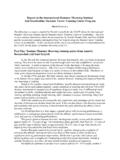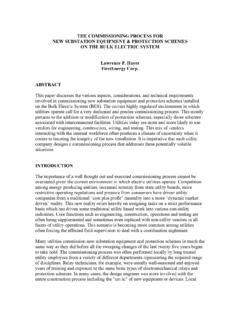Transcription of RMS OLYMPIC: THE MIS-DATED REFIT - Mark Chirnside
1 Page 1 of 4 Mark Chirnside s Reception Room: 2004-present RMS olympic : THE MIS-DATED REFIT By Mark Chirnside This article, originally published in August 2006 was updated in May 2018. lympic underwent a number of major refits during her career. One in 1912-13 followed Titanic s loss, incorporating new safety features and improvements largely confined to her first class accommodation. In 1919-20 came the conversion from a coal-burner to an oil-burner, and the restoration of her interiors for the post-war period. By 1928, her interiors were upgraded to cope with increasing competition for passengers. In 1932-33 olympic s final major REFIT involved engine work and further changes in passenger accommodation.
2 However, changes that many researchers have attributed to a single major REFIT in 1928 were actually incorporated over two refits, during the winter of 1927-28 and then again in 1928-29. We have documentation from 1927 as to some of the changes which involved creating the new tourist third class public rooms aft. (One of these is shown in the 1931 deck plan presented in the Poderjay article on this website.) It seems certain that this work was completed while olympic was out of service for around a month between late December 1927 and late January 1928. The New York Times referred to the changes in tourist third class and reported in February 1928: but the first class accommodations have been changed also.
3 Suites de luxe [sic] have been installed. It spoke in general terms and said: cabins have been altered, companionways constructed, bulkheads and doorways built and old ones removed, all within six weeks. At first glance, the newspaper s statements might have seemed to confirm the view that the first class promenade forward of the grand staircase on B-deck [by 1911 lettering] was removed in the 1927-28 REFIT and replaced by the new luxury suites to cater for ever-more demanding passengers. A White Star Line brochure from 1928 mentioned changes in first class, including the redecoration of the Caf Parisian: Several additional cabins on decks A and B each with private bath and lavatory.
4 The demand O Page 2 of 4 Mark Chirnside s Reception Room: 2004-present for these deluxe accommodations always far exceeds the supply! However, the brochure made no mention of new suites on B-deck. The White Star Line saw these as a significant improvement in olympic s first class accommodation. Although they did have their own private facilities, they were hardly several additional cabins when they were in fact sixteen large luxury suites decorated in a variety of styles. Competition on the Atlantic was intensifying in the late 1920s and the White Star Line wanted to emphasize the olympic s merits to the travelling public. Failure to advertise these comfortable suites in great detail to prospective passengers would have been astonishing, negating much of the benefit in installing them in the first place.
5 Above: This summer 1934 plan shows the forward end of B-deck on the port side, after the new first class suites had been installed. From left to right, a few of the many decorative styles are indicated: Modern A16, Colonial A14, Tudor A12, and Queen Anne A10. The lettering of the first class rooms has changed, since B-deck had been renamed A-deck by this time. The deckhouse corner formed by staterooms A8, A6 and A4 indicates the original width of the deckhouse, before the promenade was removed to make room for the new suites. These three rooms were in the small minority of first class accommodation on this deck without their own private facilities, yet the occupants had a fine view. At the top of the plan the narrowing of the hull is visible as each suite closer to the bow (on the right) is shorter than the previous one.
6 The spacing of the suite windows is visible on the plan, showing that they were cut in pairs and replaced the evenly-spaced windows that had been here (forming the enclosed promenade) before the new suites were added. This change is visible in exterior photographs of the olympic taken before and after the new suites were installed. (Author s collection) Page 3 of 4 Mark Chirnside s Reception Room: 2004-present A photo in Bruce Beveridge s collection, dated June 1928, shows the windows along B-deck just as they had been since 1913, whereas photos from the 1930s clearly show the distinctive window pattern of the new suites forward on B-deck. These windows are clearly missing from the photo, which was taken after many researchers thought the new suites had been installed.
7 Newspaper references from 1929 referred to new suites being added recently, but were not precise. One reference from February 1929 stated that sixteen new staterooms in the styles of Louis XVI and Queen Anne were built and fifty-three additional private bathrooms were installed in the first class quarters. To provide the space necessary for these alterations a section of the B-deck forward of the main companionway was utilised and the rooms were extended to the side of the ship. This is a clear reference to the new B-deck suites. It noted that some of the suite rooms were twenty-two feet long, and that every single one was equipped with a private bathroom and roomy wardrobes.
8 The report also clarified when the first class dining saloon s forward bulkhead was moved forward three frames (nine feet). It noted that the dining saloon had been extended and a dance floor fitted between December 22nd 1928 and olympic s February 13th 1929 Southampton departure. The report confirms that the extension of the first class dining saloon and the installation of the new B-deck suites (as well as some of the new private baths) took place during the REFIT at the turn of 1928-29. The redecoration of the Caf Parisian, other minor changes to first class, the new tourist class public rooms, construction of new third class rooms forward on D-deck [1911 lettering] and other alterations had taken place during the 1927-28 REFIT .
9 The newspaper report is also confirmed by primary sources. The new first class suites are referred to in a comment from Board of Trade records dated March 1929: During the lay-up the first class accommodation on the bridge deck for about 98 feet at the fore end has been carried out to the [ship s] side. The plating is inches and [the] framing 6 x 4 x inch angles at the normal [hull] frame Page 4 of 4 Mark Chirnside s Reception Room: 2004-present spacing, replacing angles [of] 6 x 4 x inches on alternate Slight alterations have been made in the first class passenger accommodation by the provision of a number of bathrooms en suite. Confirming the Board of Trade notes, an emergency evacuation plan has come to light which shows olympic s new tourist class public rooms as fitted in 1927-28.
10 However, on the plan the forward end of B-deck is still in its original configuration prior to the new suites being fitted in 1928-29. This, again, confirms the work was done on separate occasions. None of this should really be too surprising. In truth, it would have been far easier to maintain olympic s hectic schedule (forty-six round trips from 1927-29) by allocating the changes to two overhauls, rather than taking the ship out of service for a longer overhaul. While I made every effort to assign these changes their correct dates in the original edition of my olympic book, I made a mistake in attributing some of the changes of 1928-29 to the REFIT over the turn of 1927-28.








